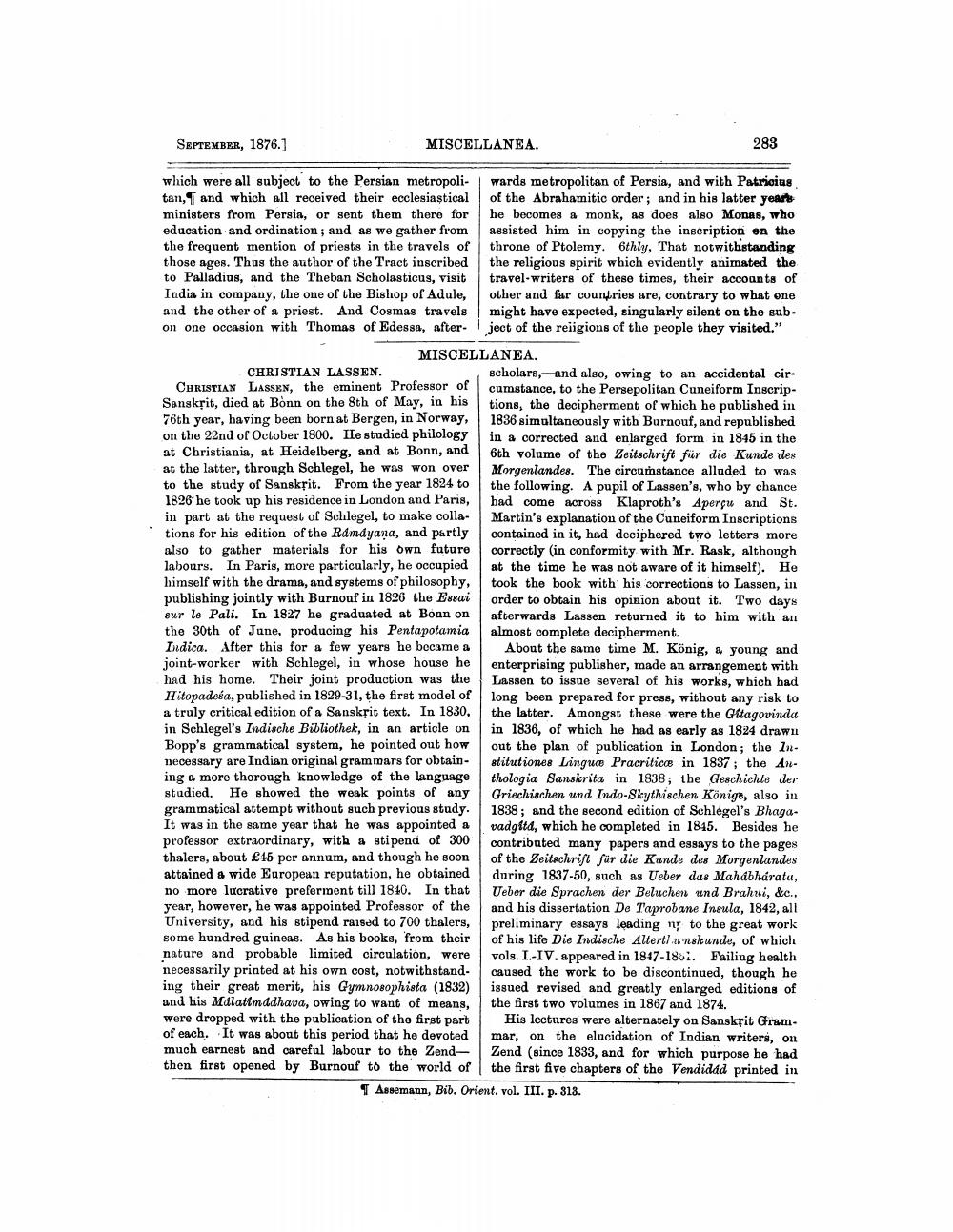________________
SEPTEMBER, 1876.]
MISCELLANEA.
283
which were all subject to the Persian metropoli- wards metropolitan of Persia, and with Patricius tan, and which all received their ecclesiastical of the Abrahamitic order; and in his latter years ministers from Persia, or sent them there for he becomes a monk, as does also Monas, who education and ordination; and as we gather from assisted him in copying the inscription on the the frequent mention of priests in the travels of throne of Ptolemy. 6thly, That notwithstanding those ages. Thus the author of the Tract inscribed the religious spirit which evidently animated the to Palladius, and the Theban Scholasticus, visit travel-writers of these times, their accounts of India in company, the one of the Bishop of Adule, other and far countries are, contrary to what one and the other of a priest. And Cosmas travels might have expected, singularly silent on the subon one occasion with Thomas of Edessa, after- ject of the reiigions of the people they visited."
MISCELLANEA. CHRISTIAN LASSEN.
scholars, and also, owing to an accidental cir. CHRISTIAN LASSEN, the eminent Professor of cumstance, to the Persepolitan Cuneiform InscripSanskrit, died at Bonn on the 8th of May, in his tions, the decipherment of which he published in
tions, the decipherment 76th year, having been born at Bergen, in Norway, 1836 simultaneously with Burnouf, and republished on the 22nd of October 1800. He studied philology in a corrected and enlarged form in 1845 in the at Christiania, at Heidelberg, and at Bonn, and
6th volume of the Zeitschrift für die Kunde des at the latter, throngh Schlegel, he was won over
Morgenlandes. The circumstance alluded to was to the study of Sanskrit. From the year 1824 to the following. A pupil of Lassen'a, who by cha 1826 he took up his residence in London and Paris, had come across Klaproth's Aperçu and St. in part at the request of Schlegel, to make colla- Martin's explanation of the Cuneiform Inscriptions tions for his edition of the Ramdyana, and partly contained in it, had deciphered two letters more also to gather materials for his own future correctly in conformity with Mr. Rask, although labours. In Paris, more particularly, he occupied at the time he was not aware of it himself). He himself with the drama, and systems of philosophy, took the book with his corrections to Lassen, in publishing jointly with Burnouf in 1826 the Essai order to obtain his opinion about it. Two days sur le Pali. In 1827 he graduated at Bonn on afterwards Lassen returned it to him with an the 30th of June, producing his Pentapotamia almost complete decipherment. Indica. After this for a few years he bocame a About the same time M. König, a young and joint-worker with Schlegel, in whose house he enterprising publisher, made an arrangement with had his home. Their joint production was the Lassen to issue several of his works, which had Hitopadesa, published in 1829-31, the first model of
long been prepared for press, without any risk to a truly critical edition of a Sansksit text. In 1830, the latter. Amongst these were the Gitagovinda in Schlegel's Indische Bibliothek, in an article on in 1836, of which he had as early as 1824 drawn Bopp's grammatical system, he pointed out how out the plan of publication in London; the Innecessary are Indian original grammars for obtain- stitutiones Lingua Pracriticæ in 1837; the An. ing a more thorough knowledge of the language thologia Sanskrita in 1838; the Geschichte der studied. He showed the weak points of any Griechischen und Indo-Skythischen Königo, also in grammatical attempt without such previous study. 1838; and the second edition of Schlegel's BhagaIt was in the same year that he was appointed a vadgitd, which he completed in 1845. Besides he professor extraordinary, with a stipend of 300 contributed many papers and essays to the pages thalers, about £45 per annum, and though he soon of the Zeitechrift für die Kunde des Morgenlandes attained a wide European reputation, he obtained during 1837-50, such as Ueber das Mahabharata, no more lucrative preferment till 1840. In that Ueber die Sprachen der Beluchen und Bralni, &c.. year, however, he was appointed Professor of the and his dissertation De Taprobane Insula, 1842, all University, and his stipend raised to 700 thalers, preliminary essays leading to the great work some hundred guineas. As his books, from their of his life Die Indische Altertranslunde, of which nature and probable limited circulation, were vols. I.-IV. appeared in 1847-1857. Failing health necessarily printed at his own cost, notwithstand- caused the work to be discontinued, though he ing their great merit, his Gymnosophista (1832) issued revised and greatly enlarged editions of and his Mulattmadhava, owing to want of means, the first two volumes in 1867 and 1874. were dropped with the publication of the first part His lectures were alternately on Sanskrit Gram. of each. It was about this period that he devoted mar, on the elucidation of Indian writers, on much earnest and careful labour to the Zend- Zend (since 1833, and for which purpose he had then first opened by Burnouf to the world of the first five chapters of the Vendidad printed in
Assemann, Bib. Orient. vol. III. p. 318.




